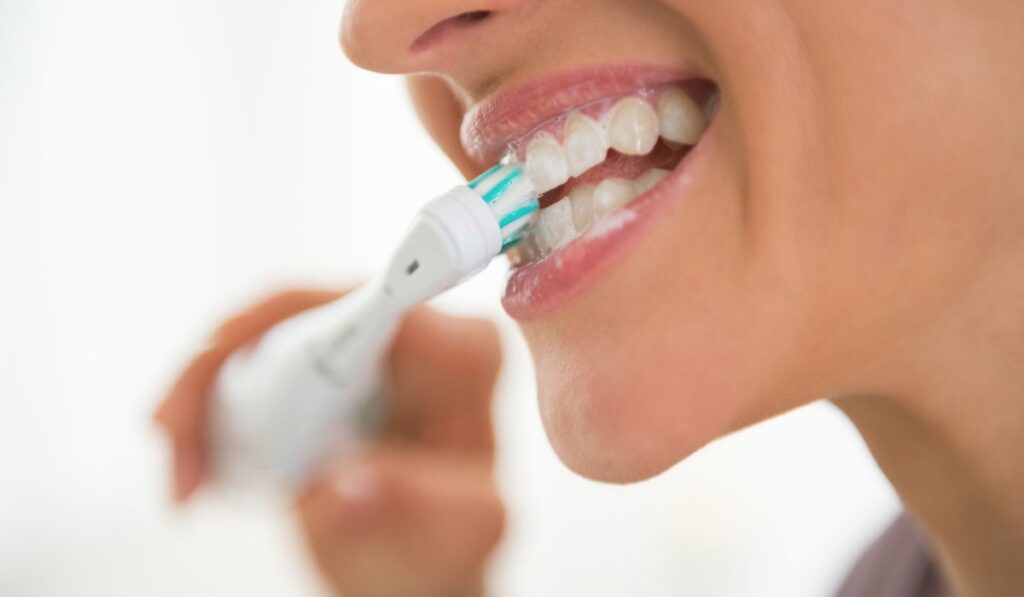Like soap, toothpaste is a foaming agent that cleans and contains ingredients that kill off harmful germs. You might wonder they’re effectively the same thing. So, is toothpaste just soap — and is it possible to maintain a healthy smile using soap instead?
Toothpaste isn’t soap. Its cleaning properties come from one of its main ingredients, a detergent called sodium lauryl sulfate (SLS). SLS helps remove bacteria from the mouth and prevent plaque buildup. Besides SLS, toothpaste also contains ingredients like abrasives, humectants, and fluoride.
Let’s look at what exactly makes soap and toothpaste different, what toothpaste is made of, and the practicality of brushing your teeth with soap.
Does Toothpaste Contain Soap?

Most toothpastes nowadays usually contain some kind of detergent in their formula, but it’s not soap. One of the most commonly used detergents is sodium lauryl sulfate (SLS), which is a synthetic surfactant. Surfactants (AKA “surface-active agents”) grab dirt so that it can be washed away from a surface.
Simply put, SLS helps to remove germs and bacteria from teeth, which in turn prevents tooth decay, gum diseases, and plaque accumulation.
What Is Toothpaste Made Of?
Among the many toothpaste options we have to choose from, you’ll find these common ingredients in most commercial brands like Crest or Colgate (both on Amazon):
Abrasives
Toothpaste contains mild abrasives to scrub off plaque accumulated on our teeth. They also scour our teeth and remove superficial stains, resulting in a brighter smile. Such abrasives include sodium bicarbonate, dicalcium phosphate, calcium carbonate, alumina, and hydrated silica.
Humectants
Humectants are responsible for toothpaste’s smooth and creamy texture, which enables it to retain its gel form by preventing water loss. Some of these humectants include xylitol, sorbitol, pentanol and glycerine.
Sweeteners and Flavorings
Toothpaste needs to taste appealing enough for everyday use, but it can’t contain sugar because of the relationship between sugar and cavities. So, manufacturers use sugar-free sweeteners like saccharin and xylitol and flavorings like cinnamon, wintergreen, peppermint, menthol and spearmint to make toothpaste more palatable.
Detergents
A common toothpaste detergent like SLS (sodium lauryl sulfate) aids in removing tiny food debris and particles. It also yields foam as you brush, which helps in the solubility and removal of plaque.
Preservatives
Toothpaste contains preservatives like sodium benzoate, ethylparaben and methylparaben to keep it fresh and prevent the growth of microorganisms. Natural toothpastes use citric acid as a preservative.
Fluoride
Fluoride adds minerals to the enamel and helps prevent cavities. It’s also the most active ingredient in toothpaste.
What Is Soap Made Of?
Soap manufacturers use several ingredients, most of which are readily available if you want to make a DIY soap. Here’s the ingredients you’ll usually come across:
- Coconut oil
- Olive oil
- Distilled water
- 100% pure lye
- Essential oils
- Colorants
- Flowers and dried herbs
Can You Brush Your Teeth With Soap?

Interestingly enough, brushing your teeth with soap is completely okay and healthy. When brushing using soap, scrubbing with the toothbrush removes food from your teeth and gums while the soap kills bacteria in your mouth and freshens your breath.
Even though soap tastes a bit odd, you’ll probably get used to its taste after around three or four brushing sessions. It’s best to go for a detergent-free bar soap containing a high portion of olive oil.
In fact, olive oil should be the first ingredient you need to check for on the soap. Avoid soaps with coconut oil as it gives most detergent and non-detergent soaps the noticeable “soapy” taste.
Brushing with soap has become trendy, giving rise to many commercial soaps formulated specifically for teeth. If you decide to ditch your regular toothpaste for soap, consider opting for a castile soap like Dr. Bronner’s (on Amazon).
A major difference between castile soap and most commercial soaps is that the commercial soaps have bitter deterrent agents added to discourage consumption. Castile soaps, on the other hand, aren’t harmful when ingested, so they don’t have any synthetic bittering agents.
How To Brush Your Teeth With Soap
Follow these simple steps to brush your teeth with castile soap:
- Wet your toothbrush with a bit of water.
- Add two drops of liquid castile soap to the toothbrush.
- Brush your teeth as usual, and don’t forget your tongue.
- Rinse at least two times with water.
- Be sure to floss in addition to brushing, as flossing remains an essential part of preventing cavities.
Note that if the castile soap you use to brush doesn’t contain fluoride, then it won’t have the anti-cavity property of traditional toothpaste.


